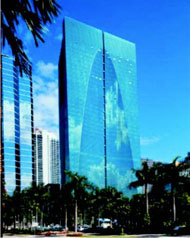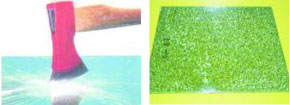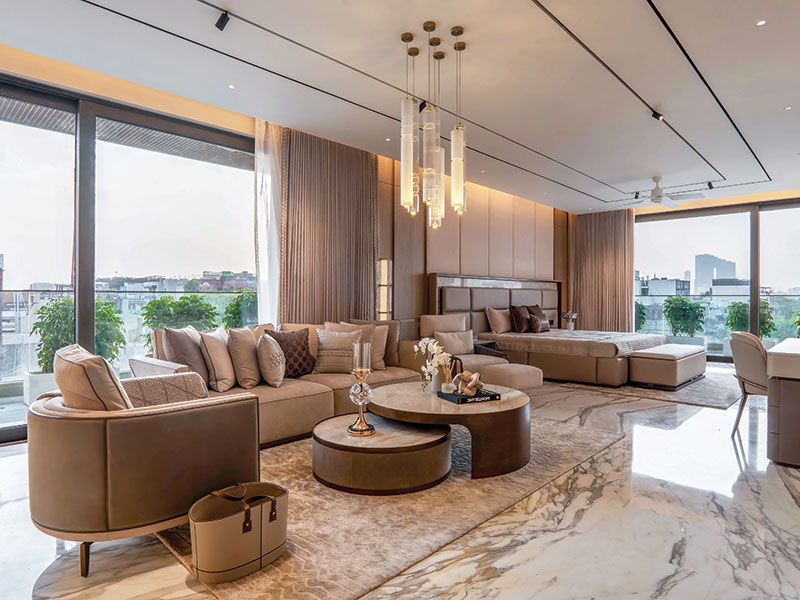

Although no single product offers complete protection, laminated glass windows and doors made with a polyvinyl butyral (PVB) interlayer can be a critical first line of defense, because the glass tends to remain in its frame. It thereby helps to protect the interior of the building from the blast wave effect of energy which causes the majority of damage to a building’s interior and surrounding buildings. Protection from flying glass is equally imperative, because as studies of bomb explosions indicate, more than 75 percent of the injuries caused by bomb blasts are glass-related.
Security Glass–The requirement
Glass is the most vulnerable point of access - an important issue for building owners and tenants. Two of three break-ins occur through glass. In fact, virtually every piece of glass represents hazardous possibilities. It takes only one blow to shatter standard or tempered glass. A hard or sharp hit with a pointed object is all that is needed; a spark plug swung on a string will allow a burglar to walk upright through a patio door in 15 seconds.Laminated glass with a polyvinyl butyral (PVB) interlayer can be used in the design of a building to protect that building, neighboring buildings and their occupants in the event of a bomb blast. When laminate-treated glass is broken, the sheet of security laminate and the anchoring system hold the glass fragments in place, creating an impenetrable barrier. This laminated glass comprises one or more pieces of glass held together by several clear, plastic films. If the glass is broken, the glazing remains in place as the fragments of glass adhere to the plastic films. In the event of attempted break–in this will prevent or slow down entry. This smashed-glass barrier dissipates the force of any further blows, denying the burglar entry. When used in conjunction with alarm systems and good locks, window security laminates provide effective protection for your home, business, or industrial facility. While nothing can guarantee to keep criminals out of your home or business, eliminating the speed and ease of entry that they rely on is usually enough to keep you from becoming their next victim.
Security glass–Made to order
Annealed glass
It is sometimes referred to as flat glass or float glass. It is also commonly called soda lime glass. Soda lime glass is optically clear and very flat. However, it breaks very easily upon impact (as its M.O.R., modulus of rupture, is only around 5,000-6,000 PSI) and produces sharp pieces.Tempered glass
This type of glass is a safety glass (not to be confused with a security glass) and is very difficult to break. It has an M.O.R in the area 36,000 PSI. When used alone as a single–ply in a window opening, this glass will "dice" into small cubes when broken. Thus, eliminating the possibility of a person being cut by a shard of glass as it falls out of the window.However, architecturally, house design and security applications require vision as well as safety. Laminated tempered glass has some drawbacks.
When it is broken, it will dice into small cubes through the entire lite but remain in place adhered to the other ply. The visibility through this lite will be greatly reduced as the break pattern of the tempered glass will affect the entire lite. Tempered glass also has a great deal of distortion due to the manufacturing process. During the heating and cooling process, the surface of tempered glass is put under tension and compression thus producing a roll wave distortion of wavy images. Tempered glass will have warpage when compared to annealed glass. The warpage makes the product more prone to delaminate.
Heat strengthened glass
This glass is produced using the same manufacturing process that is used to produce Tempered glass. The difference is that the Heat Strengthened Glass is not subjected to the heating and cooling process for as long period as TG. Thus, laminated Heat Strengthened Glass will perform differently than TG in certain ways. Heat Strengthened Glass will have distortion but to a lesser degree than Tempered Glass. Heat Strengthened Glass will warp but to a lesser degree than Tempered Glass. This glass when laminated will have a more localized break pattern (better visibility). It has less tension and compression in the surface of the glass when compared to Tempered Glass, which means the M.O.R. (modulus of rupture), is 12,000-15,000 PSI. When subjected to incidental impact it will break more.Designing with Laminated Glass to meet Security Codes and Standards
Proper security design provides protection for building occupants in case of premeditated catastrophes. Within the glazing industry, security design generally falls into three broad categories. Each category requires special design criteria for glazing systems:- Burglary and Forced Entry Resistance
- Bomb Blast Resistance
- Ballistic (bullet) Protection
Burglary and forced entry resistance
Architects and designers must remember that the entire glazing system, not just the glass panel, must be designed to withstand a forced entry attack. Since it cannot be cut from, one side, even a quiet glasscutter becomes a useless tool. Standard laminated glass made with PVB interlayer provides a significant improvement in resistance to attack from a variety of handheld weapons over ordinary monolithic glass—even those that are strengthened.Bomb blast resistance
Experts report that approximately 75% of all damage and injury from bomb blasts can be attributed to flying and falling glass following an explosion. Laminated glass made with PVB interlayer:- Substantially reduces the extent of damage and opportunity for looting.
- Substantially reduces injury and cost to repair the targeted and surrounding facilities.
- Reduces or eliminates flying glass (both in new building designs and retrofit existing windows) to assure protection of nearby non-targeted buildings.
- Withstands both the initial blast wave from the explosive event as well as debris that may impact the glazing.
Ballistic (bullet) Protection
Security glazing, consisting of the appropriate configuration of laminated glass made with protective interlayer can:- Reduce injuries from a ballistic attack, without compromising the clear-vision benefits allowed by a glass system.
- Protect from penetration of high-velocity ballistics (bullets) when constructed in multiple alternating layers of glass and protective interlayer.
Designing for Security in Residential Applications

Laminated glass offers different types of security protection: it is therefore important to determine the protection required. Various combinations and types of interlayer and glass produce different effects. Then the thickness of the glass determines the security of the laminated unit. For example, bullet-resistance laminated glass uses a particular combination of glasses and interlayer to absorb high-powered ballistic force without shattering or being penetrated. Obviously, a multi-layer combination will be used. On the other hand, to prevent forced entry, it is usually enough to use annealed and heat-strengthened glass with an interlayer. Fire protection glass is a multi-layered product that literally burns away layer by layer, thus retarding the progress of the fire. All of these products are rated by levels and are tested for specific performance criteria.
Architects prefer security measures to be inconspicuous; security officials want them to be obvious with the goal of deterring assailants. And the risks cannot be over-estimated. However, in addition to the benefits, there are also some limitations. Increased amount of glass and PVB interlayer create optical distortions and become very heavy. This sometimes compromises all the product benefits.
Major Dealers in the Market
On the global arena, Ace Clear Inc, Glass Security, LLC, Custom Glass Corporation and Armour Glass are some of the major players. In India there are number of dealers such as Aakruti glass Crafts, Asahi Safety glass, Ace Indo Canada and Auto Glass Security.The challenge ahead for architects working on Government buildings is to seamlessly integrate the life-safety and security measures with aesthetic building design. Security need not be incompatible with good design but the use of prudent precautionary measures may save countless lives and millions of dollars in damages.















